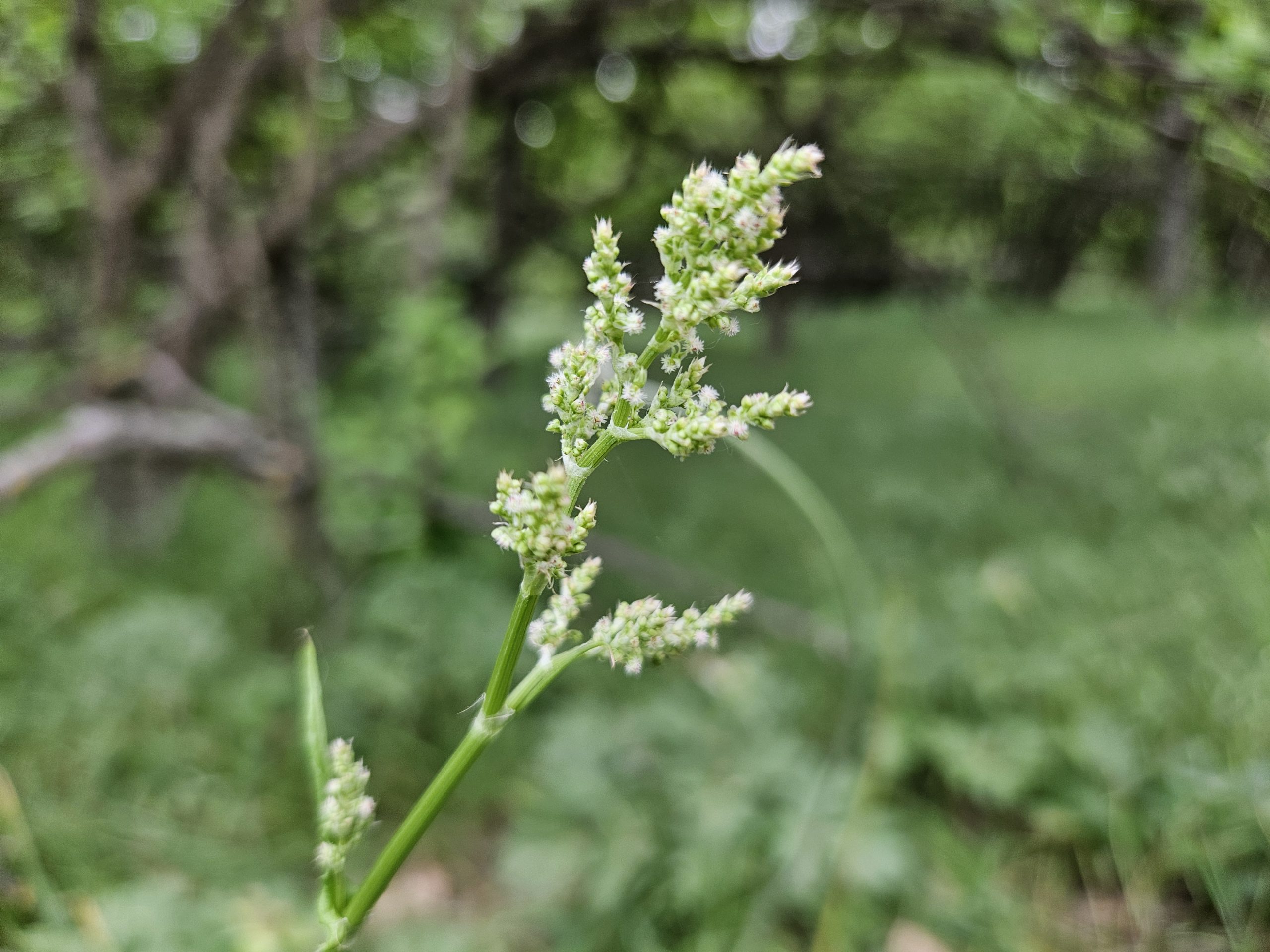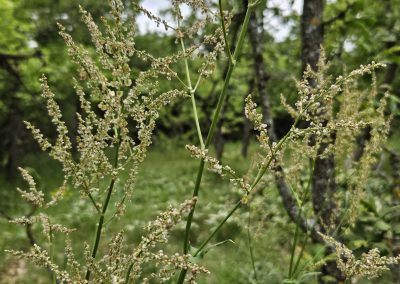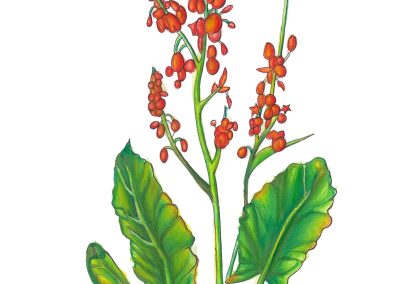Rumex acetosa
Scientific description
Rumex acetosa – Meadowsweet / Sorrel
Division: Angiospermatophyta (Magnoliophyta)
Class: Dicotyledonatae (Magnoliatae)
Subclass: Caryophyllidae
Order: Polygonales
Family: Polygonaceae
Origin: Native to temperate, hilly mountain regions of Europe
Description:
Herbaceous, perennial, dioecious plant. Thick pivoting root. Stem straight, ridged. Basal leaves elongated, long petiolate; stem leaves sessile. Inflorescences elongated, lax, simple or branched. Flowers unisexual, in whorls, spaced along panicle branches. Blooms late May. Fruit a nut, single dark brown seed, triadic in shape.
Propagation: By seed at physiological maturity.
Ecology:
Common spontaneous species, grows in meadows and glades, from plains to subalpine regions. Prefers semi-wet, damp places, frost resistant.
Use:
Edible: young leaves in salads, sour taste, rich in vitamins, iron, oxalates. Leaves eaten by animals. Root sweet-sour, eaten raw or as decoction. Medicinal value: treatment of skin diseases, tumors. High oxalic acid content – contraindicated in rheumatism or kidney disease. Can be cultivated in gardens.
Danger:
Overharvesting has caused local disappearance in some areas.
Rumex acetosa – măcriș
Încrengătura: Angiospermatophyta (Magnoliophyta)
Clasa: Dicotyledonatae (Magnoliatae)
Subclasa: Caryophyllidae
Ordinul: Polygonales
Familia: Polygonaceae
Origine: Specia nativă regiunilor temperate, coline și munți din Europa
Descrierea:
Plantă ierboasă, perenă, dioică. Rădăcină groasă și pivotantă. Tulpina dreaptă, striată. Frunze bazale alungite, lung pețiolate; frunze tulpinale sesile. Inflorescențe alungite, laxe, simple sau ramificate. Florile unisexuate, grupate în verticile, dispuse distanțat pe ramificații. Înflorește sfârșit de mai. Fruct nuculă, cu o sămânță brun închis, formă triadică.
Înmulțire: Prin semințe imediat ce fructele au ajuns la maturitatea fiziologică.
Ecologia:
Specie comună, spontană, crește în fânețe și poieni, de la câmpie până la regiunea subalpină. Preferă locuri semiumbroase, umede, jilave; rezistă la ger.
Utilizare:
Frunze tinere în salate (gust acrișor, bogate în vitamine, fier, oxalați). Frunze consumate de animale. Rădăcină dulce-acrișoară, consumată crud sau sub formă de decoct. Valoare farmaceutică: tratament boli de piele, tumori. Conținut ridicat acid oxalic – contraindicat reumatism/afecțiuni renale. Se poate cultiva în grădini.
Pericol:
Supracolectarea a dus la dispariția locală în unele zone.
Rumex acetosa – Λάπαθο
Φυλοταξία: Angiospermatophyta (Magnoliophyta)
Κλάση: Dicotyledonatae (Magnoliatae)
Υποκλάση: Caryophyllidae
Τάξη: Polygonales
Οικογένεια: Polygonaceae
Προέλευση: Είδος εγγενές σε εύκρατες περιοχές και ορεινές περιοχές Ευρώπης
Περιγραφή:
Πολυετές, διεγερτικό φυτό με αρσενικά και θηλυκά άνθη. Ρίζα παχιά, κατακόρυφη. Στέλεχος ευθύγραμμο, γραμμικό. Φύλλα βάσης λογχοειδή, με μεγάλα μίσχους· φύλλα στέλεχος άμισχα. Ανθοταξίες μακρόστενες, απλές ή διακλαδισμένες. Άνθη μονόφυλλα, σε κύκλους στις διακλαδώσεις πανικιού. Ανθίζει τέλος Μαΐου. Καρπός μικρός πυρήνας, μία σπόρος καφέ, τριγωνικός.
Αναπαραγωγή: Με σπόρους μόλις φτάσουν στη φυσιολογική ωριμότητα.
Οικολογία:
Κοινό, αυτοφυές, αναπτύσσεται σε λιβάδια και δάση, από χαμηλά μέχρι υποαλπικές περιοχές. Προτιμά ημισκιερά, υγρά μέρη, ανθεκτικό στο κρύο.
Χρήση:
Νεαρά φύλλα σε σαλάτες (ξινή γεύση, πλούσια σε βιταμίνες, σίδηρο, οξαλικά). Φύλλα τρώγονται και από ζώα. Ρίζα γλυκόξινη, καταναλώνεται ωμή ή ως αφέψημα. Φαρμακευτική αξία: δερματικές ασθένειες, όγκοι. Περιέχει υψηλή ποσότητα οξαλικού οξέος – αντενδείκνυται σε ρευματισμούς ή νεφρικά προβλήματα. Καλλιεργήσιμη σε κήπους.
Κίνδυνος:
Υπερβολική συγκομιδή έχει οδηγήσει σε εξαφάνιση σε ορισμένες περιοχές.
Rumex acetosa – Oseille
Embranchement: Angiospermatophyta (Magnoliophyta)
Classe: Dicotyledonatae (Magnoliatae)
Sous-classe: Caryophyllidae
Ordre: Polygonales
Famille: Polygonaceae
Origine: Régions tempérées, collinéennes et montagneuses d’Europe
Description:
Plante herbacée, vivace, dioïque. Racine pivotante et épaisse. Tige droite, cannelée. Feuilles basales allongées, long pétiole; feuilles caulinaires sessiles. Inflorescences allongées, lâches, simples ou ramifiées. Fleurs unisexuées, verticilles espacés sur branches d’une panicule. Floraison fin mai. Fruit akène, une seule graine brun foncé, triangulaire.
Multiplication: Par graines à maturité physiologique.
Écologie:
Espèce commune, spontanée, prairies, clairières, de la plaine à subalpin. Préfère lieux semi-humides, résiste au gel.
Utilisation:
Comestible: jeunes feuilles en salade, goût acide, riches en vitamines, fer, oxalates. Racine sucrée-acidulée, consommée crue ou décoction. Valeur médicinale: maladies de la peau, tumeurs. Riche en acide oxalique – contre-indiqué en rhumatismes/maladies rénales. Cultivable au jardin.
Danger:
Récolte excessive a causé disparition locale dans certaines régions.
Creative writing inspired by Rumex acetosa
Written by Matei Riana-Alexandra
Where Sorrel Grows
In ancient times, when the earth still spoke to people, sorrel was known as the “herb of longing.” Legend tells of two young lovers from a mountain village, separated by war. Before the boy left, the girl gave him a bundle of green, tangy leaves: “Never forget the taste of our love,” she whispered. He carried them with him across mountains and battlefields, the sharp taste always reminding him of her and the springs they shared.
Years passed, and the girl planted sorrel all around her garden, hoping its scent would guide him home. One May morning, the story says, the young man emerged from the mist, led by the tangy aroma hanging in the air. They reunited in a field full of green leaves, and sorrel became a symbol of reunion and undying memory.
Since then, people gather sorrel not only for its refreshing taste, but for the tale it carries. It is said that if you eat it while thinking of someone dear, they will dream of you that night. And if you plant it near your home, it brings luck and keeps soul bonds alive. With its slightly sour flavor, sorrel holds within it the essence of patient love and hope that never fades.






